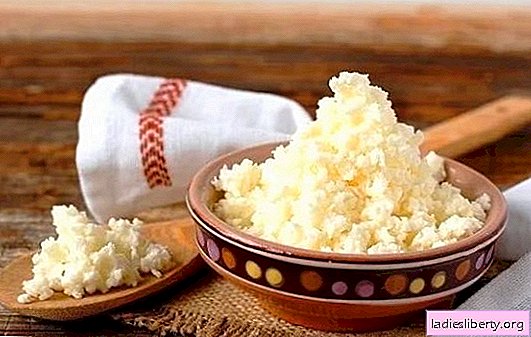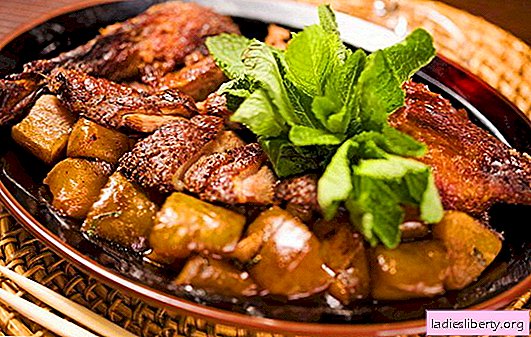
Home-made cottage cheese is the most delicious because it is always fresh and natural. You can cook it in various ways. The final result depends on the quality of milk. Someone likes fat cottage cheese, with an oily structure, and someone likes a dietary product, with a little fat and sour taste.
About how to cook cottage cheese for every taste - in detail in recipes.
Step-by-step recipes for homemade cottage cheese from milk - basic technological principles
Cottage cheese is obtained from natural (whole) milk. As you know, milk contains natural milk protein - casein. At a temperature of 10-12 ° C, the milk ripens within 12-15 hours. During this time, the structure of the protein changes, the process of natural ripening begins.
Then the milk is heated. Separation of the serum and the formation of a clot occurs: under the influence of temperature, casein fibers coagulate (contract), expelling liquid (serum) from the cells. In a production environment, this process is called pasteurization. It occurs at 63-65 ° C for 20 minutes. With increasing temperature, the pasteurization time is reduced.
In fact, milk coagulation occurs at a lower temperature - 40-45 ° С, but at dairy plants, where huge volumes of dairy raw materials collected from various farms are processed, the increase in pasteurization temperature is due to sanitary standards. When there is absolute confidence in the observance of sanitary standards during milking, in the sterility of dishes and in a satisfactory content of the animal, homemade milk can simply be warmed up before the separation of whey begins, and then removed from the stove and let it stand until completely cooled.
There is a pattern: the higher the pasteurization temperature of milk, the worse the quality of cheese grains. This is why sour boiled milk never forms a normal clot, although, again, in production conditions soft cheeses are obtained from milk processed by high-temperature pasteurization. But there are special technologies for this.
To get homemade cottage cheese, you can use some industrial secrets. Some details of industrial technology for making homemade cottage cheese from milk are in step-by-step recipes and useful tips.
Step-by-step recipe for homemade cottage cheese made from fresh milk
Ingredients:
Homemade milk 3.5 l (1 bottle)
Sourdough - the amount depends on the type of fermented milk product or enzyme
Calcium chloride 5% 5 mg (1 ampoule)
Order of preparation:
1. The first stage is the normalization of milk. Of course, it is difficult to get milk with the necessary fat content by home methods, but you can approximately adjust the process. The main thing is that the milk is whole. Fat affects taste and texture. The industry produces fat-free cottage cheese, with a fat content of 9% and 18%. Choose your option and skim the cream as needed.
2. Pour milk into a saucepan and heat to 35-40 ° C.
3. Introduce the starter in warm milk and mix for 5-7 minutes. Leave the pan at room temperature. Add calcium chloride at the same time to speed up milk clotting.
Usually, souring of milk without introducing leaven occurs within 7-8 hours. During this time, acidity increases, the product is enriched with lactobacilli, acquires a characteristic taste. This is an acidic way to cook homemade cottage cheese. He is more natural.
Adding sour cream and other dairy products speeds up the process by 2 times. Sour cream, yogurt, whey or yogurt is the most optimal way to ferment milk at home - these products are found in every home. Only one prerequisite: dairy products must be prepared in a thermostatic way, from whole milk.
If desired, replace dairy products with pepsin or other enzymes. This is the second, acid-rennet method for preparing homemade cottage cheese from milk, which can be applied by replacing sour cream with an enzyme in the second step of the recipe.
4. When a clot appears, put the pan on the stove and warm the raw materials again, stirring occasionally, at a temperature of no more than 40-42 ° С. With strong heating, the quality of the curd will deteriorate. In this case, fat and calcium will pass into serum, and the cheese clot will noticeably decrease in volume and become dry. However, this option is also acceptable, but it is not for everybody.
5. Break the resulting dense clot into small fractions to accelerate the separation of the liquid.
6. Place a strainer or colander on a pallet with a capacity of at least 3.5 liters so that the serum does not overflow over the edge of the pan. Cover the sieve with cheesecloth, folded in four layers, and carefully, gradually pour the fermented milk.
7. When the main volume of whey drains, tie the ends of the gauze napkin and hang it over the pan for a while, to seal the cheese clot and remove excess moisture from the product.
350-400 g of fresh cottage cheese can be obtained from the indicated amount of homemade milk.
Step-by-step recipe for homemade sour milk curd
Ingredient:
Homemade yogurt
It so happens that the milk is already sour, and it must be "put into action." If the product has not been boiled, then it is quite suitable for cooking homemade cottage cheese. No special additives are required for such milk.
Cooking:
1. Sour milk must be heated. When the temperature rises to 40 ° C, milk protein coagulates. All this has already been described above, in the basic technological principles for producing homemade cottage cheese from milk.
2. The next step is the separation of serum. As in the first step-by-step recipe, set the sieve on a pan of a suitable volume, and pour the warmed yogurt through a gauze layer.
3. Let the whey drain to the desired moisture level of the curd. You can leave the cottage cheese in this position, and to speed up the process of separating whey, suspend it in gauze.
Step-by-step recipe for homemade cottage cheese from milk (with lemon juice)
This is a step-by-step recipe for making "panir", Indian homemade cottage cheese made from milk. Indians use sour fruit juice to curl casein. They produce home-made rennet cheese, with a delicate taste and dense texture. This cheese is not salty, like feta cheese or feta, therefore it looks more like cottage cheese.
Ingredients:
Milk 6 L
Lemon juice 100 ml
Order of preparation:
1. Heat homemade milk to 40-50 ° C.
2. Squeeze juice from fresh lemon.
3. Pour it in a thin stream at the edge of the pan, standing on the stove, while stirring the milk in one direction.
4. Do not stop stirring until a dense clot forms.
5. Allow the mass to cool, and pour over a gauze layer laid on a colander. You can shift the clot in cheesecloth using a slotted spoon.
6. Fold the edges of the gauze to the center. Set a plate on the cheese mass, and on it - a jar filled with water. Cottage cheese must be compressed.
7. Transfer the finished head to a tightly closed container. Put in the refrigerator for ripening for 10-12 hours. Paneer served with slices. It is very good for making salads and desserts, as a filling for dumplings and pies.
At the stage of milk heating, you can add herbs and spices to get an original snack. Hot peppers, garlic, ground coriander, cardamom, mint are suitable.
Step-by-step recipes for homemade cottage cheese from milk - useful tips and secrets
Not every housewife has a lactometer to determine the fat content of milk. There is a solution: you can approximately set the percentage of fat by volume. For example: in a bottle - 3 liters of milk. Put it overnight in the refrigerator. By morning, fat will rise up, as its molecules are lighter and larger than liquid. The fat mass has a slightly creamy tint, and it differs in color from white milk. It remains to measure the volume of fat mass and determine the percentage of milk and fat. If in a bottle with a volume of 3 l, the third part is a fat “top”, milk has a fat content of about 10%. This is a good indicator of milk quality.
Homemade cow's milk has the highest fat content in the cold season, when animals are transferred to winter keeping. In such milk, fat content reaches 12%. If you need to cook low-fat cottage cheese, put milk for 7-8 hours in the refrigerator, then remove the cream - the raw material for the cottage cheese is ready.
To accelerate the coagulation of milk protein, add calcium chloride to milk raw materials. This additive is also used in the dairy industry. It allows you to increase the volume of cheese grain, enriches dairy products with calcium, which, when pasteurized, passes into whey. Calcium chloride is a cheap drug that is dispensed in any pharmacy without prescriptions. For a liter of milk, 0.5 ml of a 5% solution is enough. This is literally 2-3 drops of a solution. Chloride is an absolutely harmless drug, but you should not abuse it. As the great healer said, the medicine differs from the poison only in dosage.
Goat milk is a very valuable and dietary product. It contains less fat than cow's milk, but the coagulability of goat’s milk is lower, due to the peculiarities of the structure of milk protein. High-quality homemade goat curd can be obtained only using the acid-rennet method of ripening.
The dairy industry produces cottage cheese made from reconstituted (dried) milk, skim milk, but these methods for home-made cottage cheese are complex, require the use of special household appliances and appliances.











